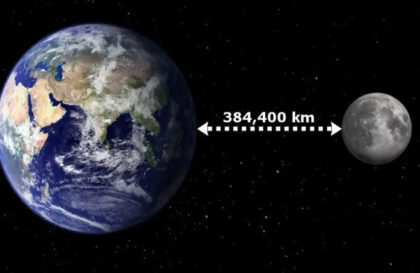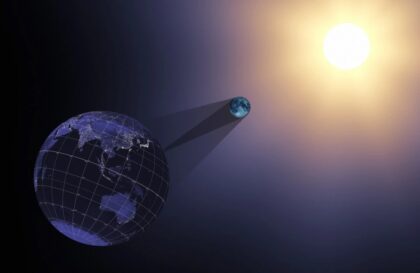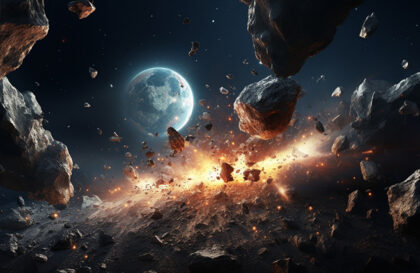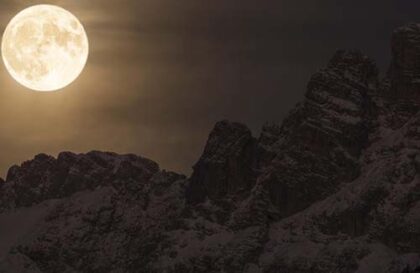The Moon formed one hundred million years after the creation of the solar system. It did not occur as a result of events related to the formation of the planets.
What caused the Moon’s birth?
A big bang?
The hypothesis of the Moon’s formation as a result of an impact is one of the most widely accepted theories of the Moon’s origin. According to this hypothesis, the Moon was formed by the collision of the early Earth with another celestial body, often referred to as “Theia”. This collision occurred about 4.5 billion years ago, in the early stages of the formation of the solar system.
According to this hypothesis, Theia, a small planet, collided with the young Earth. The collision released tremendous energy leading to the melting and ejection of large amounts of material from both planets. According to NASA, the energy involved was 100 million times greater than the much later event that is believed to have wiped out the dinosaurs.
Debris material from Earth and Theia was ejected into space. This debris began to coalesce around the Earth and formed a disk of dust and gas around our planet.
Gradually, the material in the disk began to accumulate and merge under the influence of gravity. This led to the formation of the young Moon.
The young Moon cooled down and its inner material began to separate into layers such as the crust, mantle, and core.
This hypothesis explains several important aspects, including the Moon’s lack of high density compared to Earth (which would be expected if it formed independently), and similarities in the chemical composition of Earth’s mantle and the Moon’s material.
But according to the refined data in terms of composition, the Earth and the Moon are almost twins, their compositions differing by no more than a few millionths.
Similarities in the chemical composition of the Earth and Moon have been confirmed through analysis of samples brought back from the Moon by the astronauts of the Apollo missions.
Here are a few key factors and studies that confirm the similarity in the composition of the Earth and Moon:
- Samples brought from the Moon: The Apollo missions brought samples of soil and rocks from the surface of the Moon back to Earth. These samples were carefully analyzed using various techniques such as spectroscopy, X-ray diffraction, and chemical analysis. Studies have shown that many of the elements and minerals found on the Moon are similar to those present on Earth. It turns out Luna has borrowed almost nothing from Theia, and that contradicts the impact scenario.
- Isotopic composition: The isotopic composition of various elements, such as oxygen, aluminum, titanium, and others, in samples from the Moon and Earth, are similar. Isotopes are variants of elements with different numbers of neutrons in the nucleus, and their distribution may be characteristic of a particular source.
- Geochemical analyses: Comparing the chemical composition of the Moon and Earth reveals commonalities. For example, analysis of aluminum, silicon, iron, magnesium, and other elements confirms similar chemical signatures.
Multiple collisions?
In 2017, Israeli researchers from the Weizmann Institute proposed an alternative collision theory. According to it, there was more than one impact on the Earth. Several collisions generated about 20 small moons, which “stuck together” into the current Moon. Thus this theory explains the coincidence of the composition of lunar rocks with Earth rocks – the main counterargument against the giant impact.
A similar theory was proposed in 2007 by Russian physicist Nikolai Gorkavy. He called it “multi-impact”. According to the scientist, the Earth’s satellite is formed not by a single giant collision, but by many smaller ones.
Asteroids, which gradually formed the Moon in this way, could be up to 1 million pieces. Now in the solar system, there is no such number of flying objects, but a large number of craters on the back side of the Moon proves that even 3-4 billion years ago they were.
Co-formation?
The co-formation hypothesis, also known as the double formation hypothesis says that the Earth and Moon formed almost simultaneously from the same material at close cosmic distances from each other.
The main ideas of the co-formation hypothesis are:
- As soon as a protoplanetary disk of gas and dust began to form around the young solar system, condensation processes began in it, leading to the formation of many small objects (planetesimals).
- Later, in some regions of the disk, several planetesimals merged into one large body, which eventually became the early Earth. Parallel to this process, another large body formed from the remaining debris and materials in the disk, and it eventually became the Moon.
- The similarities in the chemical composition of the Earth and the Moon can be explained by the fact that they both formed from common material near each other in the protoplanetary disk.
- This hypothesis suggests that the early Earth influenced the formation of the Moon by providing material and attracting it with its gravity. This process may also have accounted for the similar chemical composition of the two bodies.
Capture?
According to this theory, the Moon first formed in another part of the solar system, far from Earth, and was captured by Earth’s gravitational field as it passed by our planet when it was within Earth’s gravitational influence. This is how Mars acquired its satellites Phobos and Deimos.
During the close approach of the Earth and the Moon, the gravitational field of the Earth began to act on the Moon stronger than its former “parent” object. This caused the Moon’s orbit to change and it was captured as a natural satellite of the Earth.
Despite the interesting aspects of the capture theory, it has many problems and limitations:
- To successfully capture the Moon by Earth would require a significant amount of energy to change the Moon’s orbit from its original position in another part of the solar system. This process would be complex and would require precise synchronization.
- The capture theory does not explain the similar chemical composition of the Earth and Moon that is observed in the analysis of the samples.
Centrifugal separation?
The author of the hypothesis of centrifugal separation of the Earth and Moon is George Darwin, son of Charles Darwin, a British astronomer, and mathematician who developed the idea in the late 19th and early 20th century. Darwin proposed that the Moon could have separated from the Earth because of the Earth’s rapid rotation, which would cause centrifugal forces leading to the separation of some of the material. This hypothesis was one of the first attempts to propose a mechanism for the formation of the Moon.
Later calculations showed that the speed of the Earth at the time was not so high that a piece of that size could “fall off” from it. Also, if the theory were correct, the Moon would likely have been rotating around the Earth’s equator, but it wasn’t.
Evaporation?
The evaporation hypothesis was proposed by American geochemist Robert Daly in 1946. According to this hypothesis, the early Earth was exposed to intense solar radiation and winds, which caused molecules to evaporate from its surface. The vaporized molecules then condensed into a cloud of gas around the Earth, which gradually began to accumulate and thicken due to gravity. Eventually, the material in the cloud of gas reached the level of condensation at which the young Moon began to form.
But vaporization from the Earth’s surface would have required a significant amount of energy to occur. In addition, the process of condensation and formation of the Moon from the gas cloud would also have required a large amount of energy.
Plus, scientific studies of the Moon and other celestial bodies have found no evidence to support this hypothesis. It also fails to explain some features such as the angular momentum and orbital parameters of the Moon.
The evaporation hypothesis requires complex mechanisms for the evaporation, condensation, and formation of the Moon, but does not provide clear mechanisms to explain these processes.
I wonder which hypothesis is the most likely?
Image credit:
https://trends.rbc.ru






